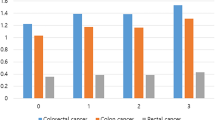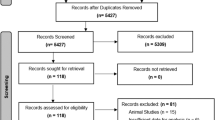Abstract
Body fatness is a risk factor for colorectal cancer, and promotes an inflammatory environment. Indeed, inflammation in normal colorectal mucosa may be a factor linking body fatness to colorectal carcinogenesis. In this study, we evaluated myeloperoxidase (MPO)-positive cells infiltration of normal colorectal mucosa as a marker of cancer-promoting inflammation in overweight and obese subjects. One hundred and three subjects with normal colonoscopy entered the study. Waist circumference (WC) and body mass index (BMI) were measured, and MPO-positive cells on histological sections of biopsies of normal colorectal mucosa were counted under a light microscope. The occurrence of adenomas was then evaluated on follow-up colonoscopies. Mean MPO-positive cell count (±s.e.m.) was higher in subject with a WC equal or above the obesity cutoff values according to gender (2.63±0.20 vs 2.06±0.18, P=0.03), and in subjects with BMI equal or above 25 kg m−2 (2.54±0.18 vs 1.97±0.20, P=0.03). A Cox proportional hazard model showed that mean MPO-positive cell count in normal colorectal mucosa was the only factor independently related to occurrence of adenomas in follow-up colonoscopies. Though preliminary, these results show that MPO-positive cell infiltration in normal colorectal mucosa is related with body fatness, as evaluated by WC and BMI, and it may be considered a useful and simple marker to estimate adenoma occurrence risk.
This is a preview of subscription content, access via your institution
Access options
Subscribe to this journal
Receive 12 print issues and online access
$259.00 per year
only $21.58 per issue
Buy this article
- Purchase on Springer Link
- Instant access to full article PDF
Prices may be subject to local taxes which are calculated during checkout


Similar content being viewed by others
References
Pischon T, Boeing H, Hoffmann K, Bergmann M, Schulze MB, Overvad K et al. General and abdominal adiposity and risk of death in Europe. N Engl J Med 2008; 359: 2105–2120.
World Cancer Research Fund/American Institute for Cancer Research. Continuous Update Project Report. Food, Nutrition, Physical Activity, and the Prevention of Colorectal Cancer, 2011..
Campbell PT, Jacobs ET, Ulrich CM, Figueiredo JC, Poynter JN, McLaughlin JR et al. Case-control study of overweight, obesity, and colorectal cancer risk, overall and by tumor microsatellite instability status. J Natl Cancer Inst 2010; 102: 391–400.
Alemán JO, Eusebi LH, Ricciardiello L, Patidar K, Sanyal AJ, Holt PR . Mechanisms of obesity-induced gastrointestinal neoplasia. Gastroenterology 2014; 146: 357–373.
Bruce WR, Giacca A, Medline A . Possible mechanisms relating diet and risk of colon cancer. Cancer Epidemiol Biomarkers Prev 2000; 9: 1271–1279.
Lin JH, Giovannucci E . Sex hormones and colorectal cancer: what have we learned so far? J Natl Cancer Inst 2010; 102: 1746–1747.
Poullis A, Foster R, Shetty A, Fagerhol MK, Mendall MA . Bowel inflammation as measured by fecal calprotectin: a link between lifestyle factors and colorectal cancer risk. Cancer Epidemiol Biomarkers Prev 2004; 13: 279–284.
John BJ, Abulafi AM, Poullis A, Mendall MA . Chronic subclinical bowel inflammation may explain increased risk of colorectal cancer in obese people. Gut 2007; 56: 1034–1035.
Fontana L, Eagon JC, Trujillo ME, Scherer PE, Klein S . Visceral fat adipokine secretion is associated with systemic inflammation in obese humans. Diabetes 2007; 56: 1010–1013.
Roncucci L, Mora E, Mariani F, Bursi S, Pezzi A, Rossi G et al. Myeloperoxidase-positive cell infiltration in colorectal carcinogenesis as indicator of colorectal cancer risk. Cancer Epidemiol Biomarkers Prev 2008; 17: 2291–2297.
Okorodudu DO, Jumean MF, Montori VM, Romero-Corral A, Somers VK, Erwin PJ et al. Diagnostic performance of body mass index to identify obesity as defined by body adiposity: a systematic review and meta-analysis. Int J Obes 2010; 34: 791–799.
Ben Q, An W, Jiang Y, Zhan X, Du Y, Cai QC et al. Body mass index increases risk for colorectal adenomas based on meta-analysis. Gastroenterology 2012; 142: 762–772.
Lee YJ, Myung SK, Cho B, Park BJ, Park JH, Ju W et al. Adiposity and the risk of colorectal adenomatous polyps: a meta-analysis. Cancer Causes Control 2011; 22: 1021–1035.
Hong S, Cai Q, Chen D, Zhu W, Huang W, Li Z . Abdominal obesity and the risk of colorectal adenoma: a meta-analysis of observational studies. Eur J Cancer Prev 2012; 21: 523–531.
Levine JS, Ahnen DJ . Clinical practice. Adenomatous polyps of the colon. N Engl J Med 2006; 355: 2551–2557.
Acknowledgements
We thank the Associazione per la Ricerca sui Tumori Intestinali (ARTI) for the support given to the study.
Author contributions
FM contributed to the conception and design of the study, patient recruitment, collection, analysis and interpretation of the data, drafting of the article and critical revision of the manuscript; VB, AB and AM contributed to patient recruitment and data collection; MP, GR, SM and PS contributed to critical revision of manuscript; PB contributed to statistical analyses; and LR contributed to conception and design of the study, analysis and interpretation of the data, and final approval of the article.
Author information
Authors and Affiliations
Corresponding author
Ethics declarations
Competing interests
The authors declare no conflict of interest.
Additional information
Supplementary Information accompanies this paper on International Journal of Obesity website
Supplementary information
Rights and permissions
About this article
Cite this article
Mariani, F., Boarino, V., Bertani, A. et al. Myeloperoxidase-positive cell infiltration of normal colorectal mucosa is related to body fatness and is predictive of adenoma occurrence. Int J Obes 41, 982–985 (2017). https://doi.org/10.1038/ijo.2017.80
Received:
Revised:
Accepted:
Published:
Issue Date:
DOI: https://doi.org/10.1038/ijo.2017.80



